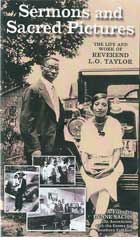
Sermons and Sacred Pictures 1989
Distributed by First Run/Icarus Films, 32 Court St., 21st Floor, Brooklyn, NY 11201; 800-876-1710
Produced by Lynne Sachs
Directed by Lynne Sachs
VHS, color and b&, 29 min.
College - Adult
African American Studies
Date Entered: 03/10/2005
Reviewed by Danna Bell-Russel, Digital Reference Team, Library of CongressReverend L.O. Taylor was a man with many talents. Considered to be an outstanding preacher, he also was considered to be an excellent writer, counselor and candy maker. What made Taylor most popular within the Memphis, Tennessee community were his films and photographs documenting African American life in Memphis in the 1930's and 40's, long before the Civil Rights Movement had an impact on the African American community. An accomplished photographer and filmmaker Taylor would present his "Taylor Made Films" at his church and in other venues around the area. Providing commentary as the films were shown, Taylor's movies documented activities in the church such as funerals and baptisms but also presented events happening at schools and businesses around the area. Taylor's camera traveled with him to the National Baptist convention where he documented the proceedings and made sure to take images of the famous people at the convention that he could share with the people in his community. Taylor and his films were known far and wide. Pullman car porters who were on layovers would travel to his church to see his films and hear his services. He also worked to show people in the community what he was doing and made special efforts to educate children about photography and filmmaking. This film presents information on Taylor, shows some of his films and has voice over interviews with some of the people that knew and worked with Taylor including his wife. Also included are the unique cards that started off Taylor's films, some of the memorabilia Taylor obtained at the National Baptist Convention and recordings of Taylor talking about his films.
It is fascinating to see these films and to hear the stories of Reverend Taylor but there are some major issues. For the first few minutes of the movie one hears a voice but there is no image. Viewers may think that there is a problem with the film. Instead of providing natural editing cuts, moving from one section to another, the screen goes completely dark and then the image from the film comes back on the screen. This happens many times throughout the movie and is disconcerting. The voices that one hears over the film are not identified and there are no images of those who are speaking. One would not know that one of the voices they were hearing was from Reverend Taylor's wife unless they read the box for the video or did a very close reading of the credits. In many cases the sound is uneven and it is hard to hear the speakers. Often the film moves from Reverend Taylor's films to images of the church today. It appears that these are supposed to provide viewers of what the event looked like in the past and what it looks like in the present. In most cases these are not one to one comparisons and it appears that the film is just hopping between various disconnected images. Though the images and original recordings are fascinating, the way they are presented and organized is disjointed and confusing.
Though there are many problems with the film it does provide images of the African American community of Memphis as well as early images of the National Baptist convention which is still considered to be one of the largest African American organizations in the country. As there are few images documenting this time in African American history, Reverend Taylor's films provide a link to an important piece of African American history and life. We are fortunate that these films are preserved in the Center for Southern Folklore, and that this video helps to make Taylor's films available to a wider audience. Sermons and Sacred Pictures will find a home in academic libraries with large African American history collections or those that focus on Tennessee or southern history.
Awards
- 1991 Honoree, American Anthropological Association
- 1990 Award Winner, National Education Film Festival
- 1990 Honoree, Black Cultural Expo
- 1990 Best Short Documentary, Athens Film Festival
- 1990 Best Documentary, Sinking Creek Film Festival